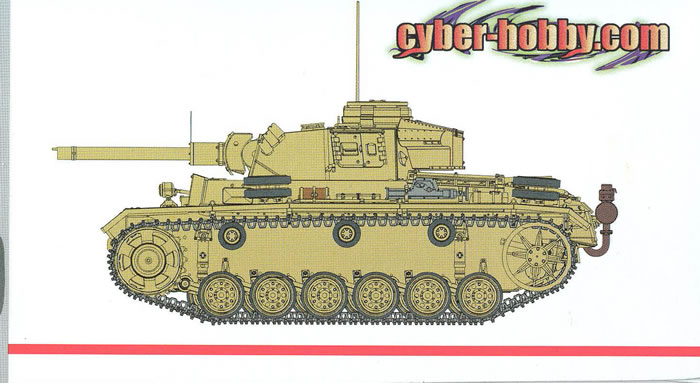|
|
|
|
| Home > Reviews > German > cyber-hobby.com 1/35 scale Kit No. 79 (Dragon Models Limited‘39-‘45 Series Kit No. 6616); Sd.Kfz. 141/3 Pz.Kpfw. III (FL) |
Sd.Kfz. 141/3 Pz.Kpfw. III (FL)
cyber-hobby, 1/35 scale
Reviewed by Cookie Sewell
Summary
| Stock Number and Description | cyber-hobby.com 1/35 scale Kit No. 79 (Dragon Models Limited‘39-‘45 Series Kit No. 6616); Sd.Kfz. 141/3 Pz.Kpfw. III (FL) |
| Scale: | 1/35 |
| Media and Contents: | 706 parts (634 in grey styrene, 29 etched brass, 22 “Magic Track” links, 19 clear styrene, 2 DS Plastic track runs) |
| Price: | price unknown but estimated at US$50 |
| Review Type: | First Look |
| Advantages: | Offers another variant on the Ausf. M version of the Panzer III (and one which actually saw service!) |
| Disadvantages: | Once again some modelers do not like the DS tracks (you can’t win!) |
| Recommendation: | Highly Recommended for WWII German fans |
FirstLook
DML’s boutique affiliate cyber-hobby.com has now released the flamethrower conversion of the Panzer III Ausf. M as their latest kit. It adds a single sprue of eight parts with the flamethrower barrel to replace the parts found in the Ausf. M with wading muffler kit (DML No. 6658).
One hundred Panzer III Ausf. M models were converted for use as flamethrowers for combat in Stalingrad, but by the time the tanks were ready Stalingrad had already fallen. As a result, the tanks only began to be fielded in mid 1943 for the attack on Kursk with both the 11th Panzer Division and “Grossdeutschland” noted as having these vehicles.
The tank mounted a 14mm flamethrower and carried 1,000 liters of fuel for the weapon; as it retained all around traverse of the turret it was more useful than the fixed flamethrower mounted on the StuG III chassis. A reduced crew of three was carried in this version.
As with its parent kit, it is a case of “mix and match” using the later DML Ausf. J/L and Ausf. N kit sprues with some new bits or replacement of some of the older ones. It comes with the split hatch early Pzkw IV style cupola and other earlier production parts.
The hull pan is a later one minus the side hatches and other detail changes such as the three return roller assemblies. It retains the full torsion bar suspension from the other kit and the detailed suspension components and muffler assembly. As with the StuG all hatches are separate with some interior details and can be positioned as the modeler chooses. All engine deck ventilators are spaced and mounted on separate frames to get the correct appearance and “lift” needed to give an accurate representation of the original.
The kit provides options for blackout or clear headlight lenses and the “kugel” mount for the bow machine gun. All viewports and viewers may be positioned open or closed as well.
Once again this kit includes the rudiments of an interior, which accurate as far as they go. This should please the “after market boys” as there is more than enough room for a nice resin interior here and enough ports and hatches to see it.
This kit offers the 40 cm DS Plastic tracks which many modelers prefer if only for the reason that it cuts four to twelve hours of their build time. DML does not indicate the length of the tracks needed as they do with their 1/72 kits so I cannot determine if they will have a loose or tight fit. Note that the tracks are dubbed “L” and “R” in the parts sheet but “Y”
and “Z” in the directions – just note that from head-on the “bar” part of the track link faces down and there is a bolt head on the outside of the track.
Technical consultants on the kit are Thomas Anderson, Tom Cockle and Gary Edmundson.
Even with two identified user units, the kit provides only one finishing option: Unidentified Unit, Eastern Front 1943 (sand, no markings). (Note that the photo on Page 69 of the Chamberlain/Ellis/Jentz encyclopedia shows a sand painted FL with crosses on the hull sides and rear, some sort of divisional insignia, and the turret number 107 in what may be red with a white outline.) Cartograf provides a small sheet with red and white turret numbers, crosses, and a good selection of divisional insignia (perhaps the input from the technical consultants got to Cartograf but not the fellows doing the directions!)
Overall this is at least a vehicle which WAS built and saw service and fills in a niche in Panzer III variants.
Sprue Layout:
A 88 Pzkw III upper hull details, center section
A 35 Pzkw III M hull details, muffler
A 61x2 StuG III Wheels and torsion bars (7 mini-sprues connected)
B 46 StuG III Road wheel arms and lower hull details
C 8 Flamethrower conversion parts
C 41 Pzkw III J applique armor and details
D 31 StuG III basic upper hull details
D 34 Pzkw III turret details
E 15 Pzkw III J turret and mantelet details
F 15 Pzkw IV cupola
G 11 Pzkw III mantlet details, fenders
G 18 StuG III OVM and light components
G 54 StuG III fender and smoke grenade launcher parts
G 52 Pzkw IV F - turret and hull details
H 35 Pzkw III M/N upper hull and engine deck
H 1 Lower hull pan
L 1 DS Plastic track - left
15 Pzkw IV F Clear styrene
P 4 Clear styrene
Q 22 “Magic Track” single links
R 1 DS Plastic Track - right
R 28 Pzkw III M/N turret schurzen array, brackets
MA 29 Etched brass
Thanks to Freddie Leung for the review sample.


